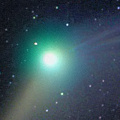
|
Now it is 6.2 mag (Dec. 4, Neil Norman). It was expected to brighten up to 4-5 mag from autumn to winter. However, the brightness evolution has stopped in September. In the Northern Hemisphere, it is appearing in the morning sky. It will be observable in excellent condition after this. In the Southern Hemisphere, it is hardly observable after this.
Date(TT) R.A. (2000) Decl. Delta r Elong. m1 Best Time(A, h)
Dec. 5 14 18.54 -9 5.4 1.461 0.899 37 5.9 5:22 (295, 18)
Dec. 12 14 17.90 -4 17.3 1.319 0.959 46 5.8 5:27 (297, 27)
|

|
It brightened very rapidly. Now it is so bright as 9.1 mag (Dec. 4, Maik Meyer). It is observable at 9-10 mag until spring in excellent condition in the Northern Hemisphere. It keeps unobservable in the Southern Hemisphere.
Date(TT) R.A. (2000) Decl. Delta r Elong. m1 Best Time(A, h)
Dec. 5 16 44.31 64 28.6 1.913 2.101 86 9.3 5:22 (209, 28)
Dec. 12 16 48.54 63 15.9 1.918 2.101 86 9.3 5:27 (212, 31)
|
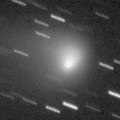
|
Now it is so bright as 9.8 mag (Dec. 4, Maik Meyer). It will pass close to the earth from spring to summer in 2016, and it is expected to be observable at 6-7 mag in good condition. It is observable in excellent condition in the Northern Hemispehre. It locates very low in the Southern Hemisphere.
Date(TT) R.A. (2000) Decl. Delta r Elong. m1 Best Time(A, h)
Dec. 5 1 24.22 36 44.8 1.537 2.339 134 10.1 20:27 (180, 88)
Dec. 12 0 56.36 32 38.0 1.572 2.266 123 10.0 19:32 ( 0, 87)
|
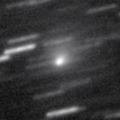
|
It brightened very rapidly. Now it is bright as 9.2 mag (Nov. 30, Juan Jose Gonzalez). It keeps 11-13 mag until February. But it keeps very low.
Date(TT) R.A. (2000) Decl. Delta r Elong. m1 Best Time(A, h)
Dec. 5 20 4.47 -24 57.2 1.933 1.434 45 11.5 18:18 ( 43, 16)
Dec. 12 20 29.97 -24 13.0 1.971 1.448 44 11.6 18:19 ( 44, 16)
|

|
Appearing in the evening sky. Now it is bright as 12.0-12.5 mag (Dec. 8, Michael Jager). It tends to brighten very rapidly around the perihelion passage. It will fade out very rapidly after this.
Date(TT) R.A. (2000) Decl. Delta r Elong. m1 Best Time(A, h)
Dec. 5 18 36.40 -19 24.7 1.178 0.531 26 11.5 18:18 ( 62, 6)
Dec. 12 19 32.79 -17 34.4 1.094 0.598 32 12.1 18:19 ( 59, 12)
|
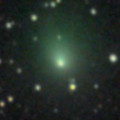
|
Now it is bright as 9.7 mag (Nov. 30, Juan Jose Gonzalez). It is observable in the evening low sky until early December in the Southern Hemisphere, or until late December in the Northern Hemisphere.
Date(TT) R.A. (2000) Decl. Delta r Elong. m1 Best Time(A, h)
Dec. 5 19 18.36 -22 41.2 2.306 1.612 35 11.5 18:18 ( 53, 10)
Dec. 12 19 41.16 -22 6.3 2.354 1.632 33 11.6 18:19 ( 54, 10)
|
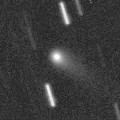
|
Now it is bright as 12.4 mag (Nov. 20, Seiichi Yoshida). It keeps 12 mag for a long time from 2015 autumn to 2016 summer. In the Northern Hemispehre, it keeps observable in good condition for a long time. It keeps unobservable in the Southern Hemisphere.
Date(TT) R.A. (2000) Decl. Delta r Elong. m1 Best Time(A, h)
Dec. 5 17 18.07 82 56.3 2.432 2.855 105 12.3 18:18 (171, 35)
Dec. 12 18 15.07 80 10.2 2.433 2.830 103 12.3 18:19 (168, 36)
|

|
First return of a periodic comet which brightened up to 8 mag in major outburst in 2010. It will be observable in excellent condition from winter to spring. Now it is not detected, fainter than 20 mag (Oct. 2, Jean-Francois Soulier).
Date(TT) R.A. (2000) Decl. Delta r Elong. m1 Best Time(A, h)
Dec. 5 9 14.79 31 59.5 1.107 1.811 119 13.1 4:22 ( 0, 87)
Dec. 12 9 24.62 32 4.9 1.028 1.781 124 12.6 4:04 ( 0, 87)
|

|
It brightened up to 3.7 mag and became a naked eye comet in mid January in 2015 (Jan. 13, Marek Biely). Now it is fading. But it is bright as 11.9 mag still now (Nov. 25, Thomas Lehmann). In the Northern Hemisphere, it keeps observable for a long time until the comet fades out, although it becomes low temporarily in December. It is not observable until March in the Southern Hemisphere.
Date(TT) R.A. (2000) Decl. Delta r Elong. m1 Best Time(A, h)
Dec. 5 17 25.17 21 42.7 4.750 4.115 45 12.9 18:18 (106, 15)
Dec. 12 17 32.07 21 8.4 4.831 4.184 44 13.0 18:19 (109, 10)
|
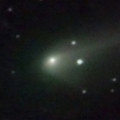
|
Now it is 12.5 mag (Nov. 20, Seiichi Yoshida). It will be fading slowly after this. In the Northern Hemisphere, it keeps observable in good condition. It will be getting higher gradually after this also in the Southern Hemisphere.
Date(TT) R.A. (2000) Decl. Delta r Elong. m1 Best Time(A, h)
Dec. 5 11 50.11 9 5.6 1.735 1.813 78 13.3 5:22 (315, 56)
Dec. 12 11 59.27 8 26.4 1.710 1.866 83 13.4 5:27 (324, 59)
|

|
It is not observable now. It will appear in the morning sky in February.
Date(TT) R.A. (2000) Decl. Delta r Elong. m1 Best Time(A, h)
Dec. 5 18 13.97 -28 12.5 6.891 5.984 21 14.0 18:18 ( 58, -5)
Dec. 12 18 20.18 -28 5.4 6.924 5.982 15 14.0 18:19 ( 62, -8)
|

|
Now it is 14.9 mag (Nov. 13, Hidetaka Sato). It will brighten up to 13 mag from winter to spring. It will be observable in excellent condition in the Southern Hemisphere. But it locates somewhat low in the Northern Hemisphere.
Date(TT) R.A. (2000) Decl. Delta r Elong. m1 Best Time(A, h)
Dec. 5 13 20.41 -7 23.0 2.687 2.203 50 14.2 5:22 (305, 29)
Dec. 12 13 33.54 -8 46.9 2.618 2.198 54 14.1 5:27 (310, 31)
|
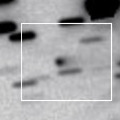
|
Now it is 15.8 mag (Nov. 20, K. Hills). It will brighten up to 11 mag from spring to summer. In the Northern Hemisphere, it keeps observable in good condition while the comet will be brightening. It locates somewhat low in the Southern Hemisphere.
Date(TT) R.A. (2000) Decl. Delta r Elong. m1 Best Time(A, h)
Dec. 5 5 51.18 19 15.1 1.631 2.592 163 14.4 0:59 ( 0, 74)
Dec. 12 5 44.53 19 13.3 1.572 2.551 171 14.2 0:25 ( 0, 74)
|

|
Now it is 14.8 mag (Nov. 22, Catalina Sky Survey). Distant object, but it keeps observable at 14-15 mag for a long time from 2015 to 2016.
Date(TT) R.A. (2000) Decl. Delta r Elong. m1 Best Time(A, h)
Dec. 5 21 33.27 -7 52.2 5.280 5.043 70 14.6 18:18 ( 34, 41)
Dec. 12 21 38.37 -7 48.8 5.367 5.031 65 14.7 18:19 ( 40, 38)
|
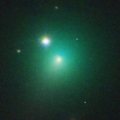
|
It brightened up to 8.8 mag in 2015 spring (Apr. 3, Marco Goiato). Now it is fading. It has already faded down to 13.5 mag (Nov. 11, Mike Wolle). It keeps observable until March when the comet becomes fainter than 18 mag.
Date(TT) R.A. (2000) Decl. Delta r Elong. m1 Best Time(A, h)
Dec. 5 1 47.35 9 31.0 1.850 2.649 136 15.0 20:52 ( 0, 65)
Dec. 12 1 46.27 9 38.2 1.965 2.693 128 15.3 20:23 ( 0, 65)
|
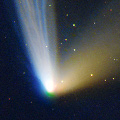
|
It approached to the sun down to 0.3 a.u. on July 6, and brighted up to 3.9 mag (July 6, Thomas Lehmann). Now it is fading. It has already faded down to 12.9 mag (Oct. 3, Chris Wyatt). In the Northern Hemisphere, it keeps observable until the comet fades out. It will not be observable after this in the Northern Hemisphere.
Date(TT) R.A. (2000) Decl. Delta r Elong. m1 Best Time(A, h)
Dec. 5 17 13.43 -55 13.8 3.614 2.844 33 15.1 18:18 ( 40,-28)
Dec. 12 17 30.67 -55 38.5 3.718 2.939 32 15.3 18:19 ( 40,-30)
|
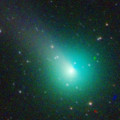
|
It brightened up to 6.0 mag in mid May (May 14, Chris Wyatt). Now it is fading. It has already faded down to 15.6 mag (Nov. 12, Sandor Szabo). In the Northern Hemisphere, it keeps observable in good condition after this while the comet will be fading. It locates somewhat low in the Southern Hemisphere.
Date(TT) R.A. (2000) Decl. Delta r Elong. m1 Best Time(A, h)
Dec. 5 7 13.97 35 11.9 2.252 3.109 144 15.2 2:22 (180, 90)
Dec. 12 6 54.51 36 29.9 2.276 3.192 154 15.3 1:36 (180, 89)
|
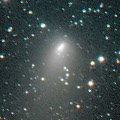
|
It brightened rapidly up to 10.4 mag from July to August (July 18, Maik Meyer). Now it is fading. It has already faded down to 14.2 mag (Nov. 11, Sandor Szabo). It is observable in good condition in the Northern Hemisphere. It is not observable in the Southern Hemisphere.
Date(TT) R.A. (2000) Decl. Delta r Elong. m1 Best Time(A, h)
Dec. 5 21 16.40 46 45.7 1.955 2.226 92 15.2 18:18 (128, 65)
Dec. 12 21 36.46 46 49.3 2.036 2.284 91 15.5 18:19 (127, 64)
|
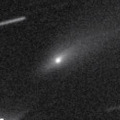
|
Now it is 13.6 mag (Nov. 12, Sandor Szabo). In the Northern Hemisphere, it keeps observable after this while the comet will be fading. It is not observable in the Southern Hemisphere until January when the comet will fade down to 16 mag.
Date(TT) R.A. (2000) Decl. Delta r Elong. m1 Best Time(A, h)
Dec. 5 13 26.11 20 23.4 2.655 2.398 64 15.2 5:22 (276, 46)
Dec. 12 13 36.25 20 14.4 2.632 2.448 68 15.3 5:27 (281, 50)
|
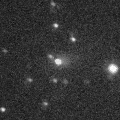
|
Now it is 14.0 mag and visible visually (Nov. 30, Chris Wyatt). Now it is passing near by the earth, and it is observable at 15 mag in excellent condition in December. It will fade out rapidly after January.
Date(TT) R.A. (2000) Decl. Delta r Elong. m1 Best Time(A, h)
Dec. 5 5 11.68 -3 15.3 0.548 1.496 153 15.4 0:20 ( 0, 52)
Dec. 12 5 9.54 -0 28.4 0.552 1.507 156 15.5 23:46 ( 0, 55)
|
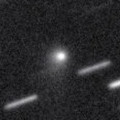
|
Now it is 15.7 mag (Nov. 11, Sandor Szabo). It keeps 15-16 mag for a long time until 2016. It keeps observable in excellent condition in the Northern Hemisphere. It keeps unobservable in the Southern Hemisphere.
Date(TT) R.A. (2000) Decl. Delta r Elong. m1 Best Time(A, h)
Dec. 5 4 25.52 73 58.8 4.536 5.204 128 15.4 23:29 (180, 51)
Dec. 12 4 7.27 74 29.4 4.547 5.209 127 15.5 22:43 (180, 50)
|
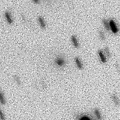
|
First return of a periodic comet discovered in 2003. Now it is 15.5 mag (Nov. 15, Yuji Ohshima). It is brightening very rapidly. It will approach to the earth from autumn to winter, and it will brighten up to 15 mag and observable in excellent condition.
Date(TT) R.A. (2000) Decl. Delta r Elong. m1 Best Time(A, h)
Dec. 5 4 48.58 6 33.1 0.689 1.660 164 15.6 23:52 ( 0, 62)
Dec. 12 4 43.91 10 4.8 0.690 1.661 165 15.5 23:20 ( 0, 65)
|
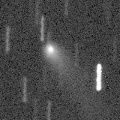
|
Now it is 15.1 mag (Nov. 11, Sandor Szabo). It keeps 15 mag for a long time from 2014 to 2015. It is observable in excellent condition in the Northern Hemisphere. It locates low in the Southern Hemisphere.
Date(TT) R.A. (2000) Decl. Delta r Elong. m1 Best Time(A, h)
Dec. 5 0 36.59 46 36.1 3.870 4.511 125 15.5 19:41 (180, 78)
Dec. 12 0 33.07 46 21.9 3.969 4.541 119 15.6 19:10 (180, 79)
|
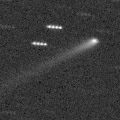
|
Now it is 15.4 mag (Nov. 15, Yuji Ohshima). It will be fading slowly after this. In the Northern Hemisphere, it keeps observable for a long time until the comet fades out. In the Southern Hemisphere, it will be unobservable in early January.
Date(TT) R.A. (2000) Decl. Delta r Elong. m1 Best Time(A, h)
Dec. 5 0 26.11 14 59.3 3.681 4.248 119 15.5 19:30 ( 0, 70)
Dec. 12 0 19.49 15 2.4 3.811 4.259 110 15.6 18:56 ( 0, 70)
|
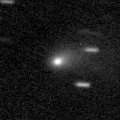
|
First return of a periodic comet discovered in 1994. It brightened up to 13.8 mag from summer to autumn (Sept. 7, Taras Prystavski). Now it is fading, but it is bright as 15.2 mag still now (Nov. 11, Sandor Szabo). It is observable in excellent condition in the Southern Hemisphere. It locates somewhat low in the Northern Hemisphere.
Date(TT) R.A. (2000) Decl. Delta r Elong. m1 Best Time(A, h)
Dec. 5 23 5.32 -16 55.9 2.300 2.479 88 15.7 18:18 ( 2, 38)
Dec. 12 23 13.20 -15 3.3 2.392 2.490 84 15.8 18:19 ( 9, 40)
|
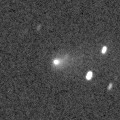
|
Now it is 14.5 mag (Nov. 11, Sandor Szabo). It keeps observable at 15 mag in good condition for a while.
Date(TT) R.A. (2000) Decl. Delta r Elong. m1 Best Time(A, h)
Dec. 5 2 9.68 3 34.7 1.332 2.170 138 15.8 21:14 ( 0, 59)
Dec. 12 2 10.63 3 53.9 1.399 2.183 131 15.9 20:48 ( 0, 59)
|

|
It brightened up to 11-12 mag in 2012. It has already faded down to 16.5 mag (July 9, Taras Prystavski). It is observable at 16 mag in good condition from winter to spring.
Date(TT) R.A. (2000) Decl. Delta r Elong. m1 Best Time(A, h)
Dec. 5 11 16.98 -7 5.5 10.699 10.565 79 16.3 5:22 (338, 45)
Dec. 12 11 16.23 -7 10.9 10.614 10.603 86 16.3 5:27 (350, 47)
|
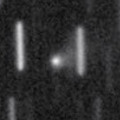
|
Brightening very rapidly, and it keeps brightening even after the perihelion passage. Now it is very bright as 15.5 mag (Nov. 21, Catalina Sky Survey). It keeps observable in excellent condition for a while.
Date(TT) R.A. (2000) Decl. Delta r Elong. m1 Best Time(A, h)
Dec. 5 6 15.38 -13 49.9 1.071 1.916 137 16.3 1:23 ( 0, 41)
Dec. 12 6 10.48 -15 1.0 1.084 1.941 139 16.4 0:51 ( 0, 40)
|
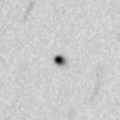
|
Now it is 16.7 mag (Nov. 5, Masayuki Suzuki). It was reported as 15.8 mag visually (Nov. 12, Sandor Szabo). It is expected to brighten up to 7 mag in 2017 summer. In the Northern Hemisphere, it keeps observable in good condition until the highlight while the comet will be brightening. In the Southern Hemisphere, it is not observable until early 2017.
Date(TT) R.A. (2000) Decl. Delta r Elong. m1 Best Time(A, h)
Dec. 5 8 15.02 59 26.8 5.567 6.217 127 16.7 3:23 (180, 66)
Dec. 12 8 11.29 60 19.5 5.459 6.158 131 16.6 2:52 (180, 65)
|

|
It brightened up to 13 mag in 2014. It is bright as 14.8 mag visually still now (Nov. 11, Sandor Szabo). It will be fading after this, and will be fainter than 18 mag in spring.
Date(TT) R.A. (2000) Decl. Delta r Elong. m1 Best Time(A, h)
Dec. 5 0 54.81 -0 22.3 3.477 4.060 120 16.7 19:59 ( 0, 55)
Dec. 12 0 54.71 -0 5.1 3.588 4.075 113 16.8 19:32 ( 0, 55)
|

|
Now it is 16.9 mag (Nov. 15, J. Bel). It will brighten up to 14 mag in 2016 summer. But it is not observable at the highlight. It keeps observable until March while the comet will be brightening gradually up to 15-16 mag.
Date(TT) R.A. (2000) Decl. Delta r Elong. m1 Best Time(A, h)
Dec. 5 0 17.29 -7 16.6 1.975 2.472 108 16.8 19:22 ( 0, 48)
Dec. 12 0 20.46 -6 47.3 2.034 2.443 102 16.7 18:58 ( 0, 48)
|

|
Now it is 17.5 mag (Nov. 13, Hidetaka Sato). It will brighten rapidly after this, and it will be observable at 14-15 mag in good condition from winter to summer.
Date(TT) R.A. (2000) Decl. Delta r Elong. m1 Best Time(A, h)
Dec. 5 12 42.16 7 56.5 2.794 2.562 66 16.9 5:22 (300, 47)
Dec. 12 12 51.09 6 39.8 2.694 2.544 70 16.8 5:27 (308, 50)
|
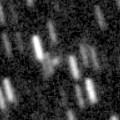
|
Now it is 17.0 mag (Nov. 3, A. Maury, J.-F. Soulier, J.-G. Bosch, T. Noel). It keeps 16.5 mag for a long time in 2016, and it will be observable in excellent condition in the Southern Hemisphere. It is hardly observable in the Northern Hemisphere.
Date(TT) R.A. (2000) Decl. Delta r Elong. m1 Best Time(A, h)
Dec. 5 8 17.96 -57 4.8 3.545 3.660 88 16.9 3:25 ( 0, -2)
Dec. 12 7 59.99 -59 23.4 3.486 3.636 90 16.8 2:40 ( 0, -4)
|
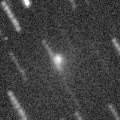
|
Now it is 16.0 mag (Nov. 12, Sandor Szabo). It is observable at 16-17 mag in good condition from October to December in the Northern Hemisphere. It is not observable in the Southern Hemisphere.
Date(TT) R.A. (2000) Decl. Delta r Elong. m1 Best Time(A, h)
Dec. 5 1 11.18 54 8.4 1.519 2.275 129 16.8 20:16 (180, 71)
Dec. 12 1 13.21 47 52.2 1.588 2.314 126 17.0 19:51 (180, 77)
|

|
Now it is 17.3 mag (Nov. 21, Catalina Sky Survey). It is observable at 16.5 mag in excellent condition from December to February. It locates somewhat low in the Southern Hemisphere.
Date(TT) R.A. (2000) Decl. Delta r Elong. m1 Best Time(A, h)
Dec. 5 8 29.27 17 29.8 1.170 1.930 126 17.3 3:36 ( 0, 72)
Dec. 12 8 33.32 17 49.0 1.117 1.930 133 17.1 3:13 ( 0, 73)
|
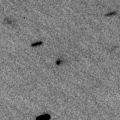
|
Now it is 16.9 mag (Nov. 17, J. Nicolas, C. Rinner, F. Kugel, A. Klotz). It will brighten up to 14 mag in 2017. In 2016, it keeps observable at 16 mag in good condition from winter to spring.
Date(TT) R.A. (2000) Decl. Delta r Elong. m1 Best Time(A, h)
Dec. 5 11 51.56 10 44.4 4.155 4.077 78 17.2 5:22 (312, 57)
Dec. 12 11 55.85 10 31.2 4.034 4.063 84 17.1 5:27 (324, 61)
|
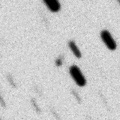
|
Now it is 17.1 mag (Nov. 17, K. Hills). It will brighten up to 16 mag in 2016 summer. In the Southern Hemisphere, it keeps observable in good condition for a long time. In the Northern Hemisphere, it is observable only until next March.
Date(TT) R.A. (2000) Decl. Delta r Elong. m1 Best Time(A, h)
Dec. 5 5 5.58 -15 57.9 2.306 3.137 141 17.3 0:14 ( 0, 39)
Dec. 12 4 54.24 -18 26.3 2.283 3.088 138 17.2 23:30 ( 0, 36)
|
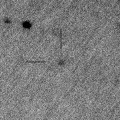
|
Now it is 17.2 mag (Nov. 18, Catalina Sky Survey). Now it is near the aphelion. It is observable at 17 mag in good condition from autumn to winter.
Date(TT) R.A. (2000) Decl. Delta r Elong. m1 Best Time(A, h)
Dec. 5 3 20.32 15 15.8 3.324 4.260 159 17.2 22:24 ( 0, 70)
Dec. 12 3 16.39 15 9.6 3.362 4.251 151 17.2 21:53 ( 0, 70)
|

|
Now it is 17.4 mag (Nov. 21, Space Surveillance Telescope, Atom Site). It is observable at 17 mag in good condition in winter.
Date(TT) R.A. (2000) Decl. Delta r Elong. m1 Best Time(A, h)
Dec. 5 8 23.19 13 29.4 1.647 2.376 127 17.3 3:31 ( 0, 68)
Dec. 12 8 24.20 14 15.1 1.575 2.370 134 17.2 3:04 ( 0, 69)
|
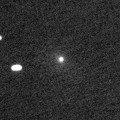
|
Now it is 16.9 mag (Nov. 14, J. Bel). It keeps observable in good condition until the comet fades out. In 2014, it must have been observable at 14 mag in good condition in the Southern Hemisphere.
Date(TT) R.A. (2000) Decl. Delta r Elong. m1 Best Time(A, h)
Dec. 5 23 55.74 3 53.9 4.454 4.853 108 17.4 19:01 ( 0, 59)
Dec. 12 23 56.61 4 15.3 4.614 4.906 101 17.5 18:34 ( 0, 59)
|
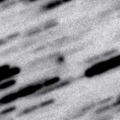
|
Now it is 16.8 mag (Nov. 20, Catalina Sky Survey). It keeps observable in good condition for a while. But it will be fainter than 18 mag in January.
Date(TT) R.A. (2000) Decl. Delta r Elong. m1 Best Time(A, h)
Dec. 5 3 46.97 26 6.8 1.838 2.806 166 17.4 22:51 ( 0, 81)
Dec. 12 3 41.86 25 33.0 1.895 2.835 158 17.5 22:18 ( 0, 81)
|
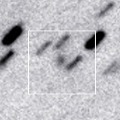
|
Now it is 17.2 mag (Nov. 7, K. Sarneczky). It keeps 17.5 mag for a long time from 2016 to 2019. It keeps locating near by the equator.
Date(TT) R.A. (2000) Decl. Delta r Elong. m1 Best Time(A, h)
Dec. 5 8 15.56 -0 57.6 9.629 10.203 123 17.5 3:23 ( 0, 54)
Dec. 12 8 14.79 -0 59.4 9.530 10.190 129 17.5 2:55 ( 0, 54)
|
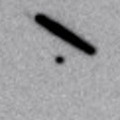
|
Now it is 17.1 mag (Nov. 17, K. Hills). It is observable in good condition in the Northern Hemisphere. It is not observable in the Southern Hemisphere.
Date(TT) R.A. (2000) Decl. Delta r Elong. m1 Best Time(A, h)
Dec. 5 11 22.43 43 8.5 1.613 2.008 98 17.5 5:22 (233, 75)
Dec. 12 11 29.40 44 7.1 1.598 2.059 103 17.5 5:27 (218, 78)
|
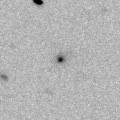
|
Now it is 17.5 mag (Oct. 28, Yasukazu Ikari). It will be fading after this. It will be fainter than 18 mag at the end of 2015.
Date(TT) R.A. (2000) Decl. Delta r Elong. m1 Best Time(A, h)
Dec. 5 23 48.97 -6 11.0 2.113 2.519 102 17.5 18:54 ( 0, 49)
Dec. 12 23 55.77 -5 22.8 2.207 2.531 97 17.7 18:33 ( 0, 50)
|

|
It will pass the perihelion in 2019. However, it has not been brightening since the discovery in 2010. Now it is 17.6 mag (Nov. 13, E. Bryssinck). It keeps observable in excellent condition from autumn to next spring in the Northern Hemisphere. It is not observable in the Southern Hemisphere.
Date(TT) R.A. (2000) Decl. Delta r Elong. m1 Best Time(A, h)
Dec. 5 3 24.04 47 51.9 9.990 10.854 149 17.7 22:28 (180, 77)
Dec. 12 3 20.88 47 50.2 9.995 10.830 146 17.7 21:58 (180, 77)
|
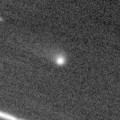
|
It brightened up to 16 mag in early 2015. Now it is fading. It is observable at 18 mag from winter to spring.
Date(TT) R.A. (2000) Decl. Delta r Elong. m1 Best Time(A, h)
Dec. 5 10 44.04 -22 40.4 5.916 5.851 81 17.7 5:22 (352, 32)
Dec. 12 10 40.48 -23 12.7 5.819 5.872 88 17.7 5:20 ( 0, 32)
|

|
Now it is 17.7 mag (Nov. 30, Hidetaka Sato). It was expected to brighten up to 14 mag from winter to summer. But it is much fainter actually. It will be observable in excellent condition in the Southern Hemisphere. It locates low in the Northern Hemisphere.
Date(TT) R.A. (2000) Decl. Delta r Elong. m1 Best Time(A, h)
Dec. 5 13 31.18 -6 3.8 2.820 2.297 49 17.8 5:22 (302, 28)
Dec. 12 13 44.61 -7 54.8 2.746 2.281 52 17.8 5:27 (307, 30)
|

|
Now it is 17.8 mag (Nov. 18, M. Adamovsky). It will brighten up to 13 mag in 2016 summer. But it is not observable around the highlight. In the Southern Hemisphere, it is observable until February when it brightens up to 17 mag. In the Northern Hemisphere, it is observable until April when it brightens up to 16 mag.
Date(TT) R.A. (2000) Decl. Delta r Elong. m1 Best Time(A, h)
Dec. 5 2 0.60 12 44.6 2.849 3.661 140 17.9 21:05 ( 0, 68)
Dec. 12 1 57.30 12 12.2 2.855 3.591 132 17.8 20:34 ( 0, 67)
|
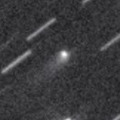
|
It keeps 17-18 mag for a long time since 2013. In the Northern Hemisphere, it is observable at 18 mag in good condition also in this winter. It is not observable in the Southern Hemisphere.
Date(TT) R.A. (2000) Decl. Delta r Elong. m1 Best Time(A, h)
Dec. 5 14 25.73 52 32.9 7.294 7.199 80 17.9 5:22 (228, 43)
Dec. 12 14 27.33 53 1.1 7.252 7.219 84 17.9 5:27 (227, 48)
|
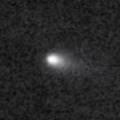
|
It brightened up to 15.9 mag in June as predicted (June 23, Ken-ichi Kadota). It was expected to be observable at 13 mag in good condition from summer to autumn. However, Jean-Gabriel Bosch detected the comet became disintegrating in July. Now it is so faint as 20.1 mag (Oct. 15, Pan-STARRS 1, Haleakala). The fragment D and B are also observed as 18.6 mag (Oct. 31, Catalina Sky Survey) and 20.9 mag (Aug. 21, Pan-STARRS 1, Haleakala) respectively.
Date(TT) R.A. (2000) Decl. Delta r Elong. m1 Best Time(A, h)
Dec. 5 1 58.83 6 30.1 1.174 2.013 137 20.4 21:03 ( 0, 62)
Dec. 12 2 0.94 7 21.8 1.260 2.047 131 20.6 20:38 ( 0, 63)
|
|
![]()
 C/2014 Q2 ( Lovejoy )
C/2014 Q2 ( Lovejoy ) 67P/Churyumov-Gerasimenko
67P/Churyumov-Gerasimenko 29P/Schwassmann-Wachmann 1
29P/Schwassmann-Wachmann 1 116P/Wild 4
116P/Wild 4 81P/Wild 2
81P/Wild 2 C/2011 KP36 ( Spacewatch )
C/2011 KP36 ( Spacewatch ) 88P/Howell
88P/Howell C/2014 Q1 ( PanSTARRS )
C/2014 Q1 ( PanSTARRS ) C/2015 G2 ( MASTER )
C/2015 G2 ( MASTER ) C/2015 F4 ( Jacques )
C/2015 F4 ( Jacques ) 19P/Borrelly
19P/Borrelly 230P/LINEAR
230P/LINEAR C/2013 V4 ( Catalina )
C/2013 V4 ( Catalina ) 329P/2015 T1 ( LINEAR-Catalina )
329P/2015 T1 ( LINEAR-Catalina ) C/2014 N3 ( NEOWISE )
C/2014 N3 ( NEOWISE ) C/2014 A4 ( SONEAR )
C/2014 A4 ( SONEAR ) 318P/2014 M6 ( McNaught-Hartley )
318P/2014 M6 ( McNaught-Hartley ) 61P/Shajn-Schaldach
61P/Shajn-Schaldach C/2006 S3 ( LONEOS )
C/2006 S3 ( LONEOS ) P/2015 Q1 ( Scotti )
P/2015 Q1 ( Scotti ) C/2015 V2 ( Johnson )
C/2015 V2 ( Johnson ) 117P/Helin-Roman-Alu 1
117P/Helin-Roman-Alu 1 118P/Shoemaker-Levy 4
118P/Shoemaker-Levy 4 77P/Longmore
77P/Longmore C/2015 B2 ( PanSTARRS )
C/2015 B2 ( PanSTARRS ) C/2015 GX ( PanSTARRS )
C/2015 GX ( PanSTARRS ) 204P/LINEAR-NEAT
204P/LINEAR-NEAT 65P/Gunn
65P/Gunn C/2015 T4 ( PanSTARRS )
C/2015 T4 ( PanSTARRS ) 74P/Smirnova-Chernykh
74P/Smirnova-Chernykh 211P/Hill
211P/Hill C/2015 K1 ( MASTER )
C/2015 K1 ( MASTER ) 44P/Reinmuth 2
44P/Reinmuth 2 C/2014 B1 ( Schwartz )
C/2014 B1 ( Schwartz ) 162P/Siding Spring
162P/Siding Spring 151P/Helin
151P/Helin C/2010 U3 ( Boattini )
C/2010 U3 ( Boattini ) C/2013 G9 ( Tenagra )
C/2013 G9 ( Tenagra ) C/2014 Y1 ( PanSTARRS )
C/2014 Y1 ( PanSTARRS ) C/2015 TQ209 ( LINEAR )
C/2015 TQ209 ( LINEAR ) C/2012 K8 ( Lemmon )
C/2012 K8 ( Lemmon ) 51P/Harrington
51P/Harrington![]()












































